The first batch of images has been pushed to https://www.missionjuno.swri.edu/
Full Version: Juno Perijove 17
Thank you! Just pulled the latest spice kernels and will jump on the imagery hopefully tonight :-)
PJ17, part 1, drafts, and enhanced reprojections, PNG.
Here the JPG version of the reprojections:
#17:
Click to view attachment
#16:
Click to view attachment
#15:
Click to view attachment
Here the JPG version of the reprojections:
#17:
Click to view attachment
#16:
Click to view attachment
#15:
Click to view attachment
Image 17 in approximately true color/contrast versions and enhanced versions:
Click to view attachmentClick to view attachment
Click to view attachmentClick to view attachment
And a subset of the associated metadata:
IMAGE_TIME = 2018-12-21T16:45:54.743
MISSION_PHASE_NAME = PERIJOVE 17
PRODUCT_ID = JNCE_2018355_17C00017_V01
SPACECRAFT_ALTITUDE = 15092.3 km
SPACECRAFT_NAME = JUNO
SUB_SPACECRAFT_LATITUDE = 55.4658
SUB_SPACECRAFT_LONGITUDE = 138.6954
TITLE = PJ17 Jet N5
Resolution at nadir: ~10.2 km/pixel
Click to view attachmentClick to view attachment
Click to view attachmentClick to view attachment
And a subset of the associated metadata:
IMAGE_TIME = 2018-12-21T16:45:54.743
MISSION_PHASE_NAME = PERIJOVE 17
PRODUCT_ID = JNCE_2018355_17C00017_V01
SPACECRAFT_ALTITUDE = 15092.3 km
SPACECRAFT_NAME = JUNO
SUB_SPACECRAFT_LATITUDE = 55.4658
SUB_SPACECRAFT_LONGITUDE = 138.6954
TITLE = PJ17 Jet N5
Resolution at nadir: ~10.2 km/pixel
Kinda like the vibe of the raw version of #17:
https://i.imgur.com/H9jCoBk.png
https://i.imgur.com/H9jCoBk.png
My take on #016, using Gerald's drafts. Warped the color channels a little for better alignment and removed the slight parabolic curve from the horizon.
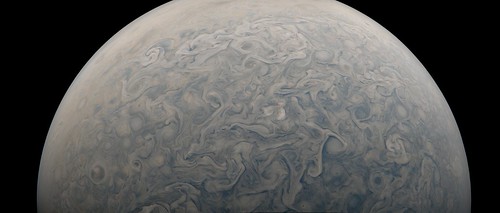
Folded Filamentary Regions - Juno

Folded Filamentary Regions - Juno
Y'all may want to take a peek at the Io images just posted on missionjuno.
There's a whole bunch of new moony images!
I think your processing may be filtering out an interesting aspect of the Io images, especially pj17-006.
Where's Jason Perry when you need him?
This is image PJ17_13 in two different versions:
Click to view attachment
At left is an approximately true color/contrast version. The version at right is also approximately true color/contrast but the effects of the variable illumination have been removed. This reveals details in dimly lit areas near the terminator, including on the night side just beyond the terminator (there the night side is faintly illuminated by scattered light from Jupiter's sky). The bluish color near the terminator in the image at right is a processing artifact and not a real feature.
Click to view attachment
At left is an approximately true color/contrast version. The version at right is also approximately true color/contrast but the effects of the variable illumination have been removed. This reveals details in dimly lit areas near the terminator, including on the night side just beyond the terminator (there the night side is faintly illuminated by scattered light from Jupiter's sky). The bluish color near the terminator in the image at right is a processing artifact and not a real feature.
https://www.swri.org/press-release/light-fr...no-jupiter-moon
QUOTE
A team of space scientists has captured new images of a volcanic plume on Jupiterís moon Io during the Juno missionís 17th flyby of the gas giant.
Thanks Mike. They are suprised Juno can detect plumes but they donít provide the distance from the spacecraft to Io. Anyone get the information?
Thanks
Thanks
They are suprised Juno can detect plumes but they donít provide the distance from the spacecraft to Io.
I didn't have much to do with this press release.
If you read the Junocam image caption, it says "The image... was acquired at 12:20 (UTC) on Dec. 21, 2018. The Juno spacecraft was approximately 300,000 km from Io."
SPICE Geometry calculator is your friend:
https://wgc.jpl.nasa.gov:8443/webgeocalc/
46.9298 N, 75.3948 W
299,083 km
Sorry Mike, I had a lot of family in town for the holidays so I haven't been keeping up with Juno lately (besides I usually focus on JIRAM data when it hits the PDS). Congrats to your team on an amazing photo of a plume!
Now that I am back at work, I get a nice Io diversion! YAY!
Plume is from Chalybes Regio eruption, btw. Most significant post-NH eruption, has been ongoing since October 2008. I'm focusing mostly on the JIRAM image from the press release. I can say that the brightest hotspot is not Chalybes Regio, but Tvashtar, so that one is active again (it's been pretty quiescent for much of the Juno mission)
https://wgc.jpl.nasa.gov:8443/webgeocalc/
46.9298 N, 75.3948 W
299,083 km
Sorry Mike, I had a lot of family in town for the holidays so I haven't been keeping up with Juno lately (besides I usually focus on JIRAM data when it hits the PDS). Congrats to your team on an amazing photo of a plume!
Now that I am back at work, I get a nice Io diversion! YAY!
Plume is from Chalybes Regio eruption, btw. Most significant post-NH eruption, has been ongoing since October 2008. I'm focusing mostly on the JIRAM image from the press release. I can say that the brightest hotspot is not Chalybes Regio, but Tvashtar, so that one is active again (it's been pretty quiescent for much of the Juno mission)
Plume is from Chalybes Regio eruption, btw. Most significant post-NH eruption, has been ongoing since October 2008. I'm focusing mostly on the JIRAM image from the press release. I can say that the brightest hotspot is not Chalybes Regio, but Tvashtar, so that one is active again (it's been pretty quiescent for much of the Juno mission)
This says so much with few words. Thanks! The image release had little geological context.
Click to view attachment
Best I could do with the JIRAM image. brightest hotspot is Tvashtar (but that's not the plume, Chalybes is). other bright hotspots include Chalybes 1, Chalybes 2, Zal, Janus, Vivasvant, W Zal, Amirani, Gishbar, and Tawhaki.
Best I could do with the JIRAM image. brightest hotspot is Tvashtar (but that's not the plume, Chalybes is). other bright hotspots include Chalybes 1, Chalybes 2, Zal, Janus, Vivasvant, W Zal, Amirani, Gishbar, and Tawhaki.
Understandable. The volcano is new since Galileo and New Horizons so the area doesn't scream "major volcano" on maps.
Mostly because none of us know as much about Io as Jason does. I spent several hours on Christmas looking at maps of Io and trying to figure it out without much luck.
You'd catch hell for speculating. I know. Wasn't supposed to be an indictment! I'm just more amazed at how many questions were anticipated and answered in a single line.
Click to view attachment
This is a very preliminary overlay between the JunoCAM image and a basemap. I'll want to actually dig into the raw data to I can be sure that all images are scaled more accurately, but again, shows that the plume is coming from Chalybes Regio.Looks like the source region? Nope, that end seems to move a bit from perijove to perijove so maybe that's the flow front? Consistent with most other Io plumes.
This is a very preliminary overlay between the JunoCAM image and a basemap. I'll want to actually dig into the raw data to I can be sure that all images are scaled more accurately, but again, shows that the plume is coming from Chalybes Regio.
For scale context, our Moon would have shown 2,5 times smaller from this distance.
I better understand JunoCam capabilties now.
I better understand JunoCam capabilties now.
Here's #024, modified from Gerald's drafts. It captures the NEB from an altitude of ~5000 km.
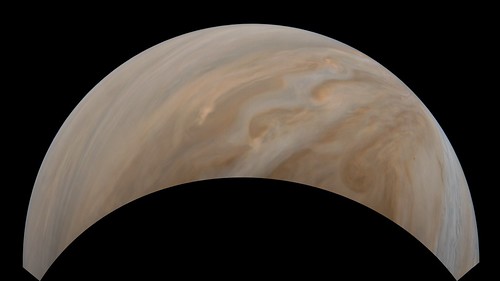 North Equatorial Belt - JunoCam
North Equatorial Belt - JunoCam
It looks like a moon shadow (likely Thebe's, if it is a shadow) is passing over the cloudtops at center right - this feature is also present in images #022 and #023 and appears to be slowly moving based on its position relative to the dark streamer beside it. Amalthea's eclipse shadow is also visible along the horizon in image #023.
 North Equatorial Belt - JunoCam
North Equatorial Belt - JunoCamIt looks like a moon shadow (likely Thebe's, if it is a shadow) is passing over the cloudtops at center right - this feature is also present in images #022 and #023 and appears to be slowly moving based on its position relative to the dark streamer beside it. Amalthea's eclipse shadow is also visible along the horizon in image #023.
Wow, you've all been rather busy, while I've been offline a few days!
Here is a link to drafts with the moon images during approach, and of part 2 close-ups.
And here reprojections of the close-ups, part 2.
Here is a jpg copy of #18:
Click to view attachment
I may continue upload of jpg copies in a few hours. In the meanwhile, you may ponder about possible moonlet shadows in images #22 to #24. I think, the shadow near the limb is real, while another candidate appears to be at a constant location, hence presumably something else.
Here is a link to drafts with the moon images during approach, and of part 2 close-ups.
And here reprojections of the close-ups, part 2.
Here is a jpg copy of #18:
Click to view attachment
I may continue upload of jpg copies in a few hours. In the meanwhile, you may ponder about possible moonlet shadows in images #22 to #24. I think, the shadow near the limb is real, while another candidate appears to be at a constant location, hence presumably something else.
Here an annotated version of #23, with arrows pointing to moonlet shadow candidates:
Click to view attachment
I've rendered cylindrical maps of images #22, 23, and 24. They showed, that the upper candidate in the rendition didn't move in a perceivable way. So, probably only the lower arrow is pointing to an actual shadow.
Click to view attachment
I've rendered cylindrical maps of images #22, 23, and 24. They showed, that the upper candidate in the rendition didn't move in a perceivable way. So, probably only the lower arrow is pointing to an actual shadow.
Some images from my pipeline. Replaced the perspective camera render in OpenGL that I was using with the panorama camera in Blender. I'm still working on the specific camera settings that I like and will try to automate it as much as possible (I'm currently doing the Blender part manually).

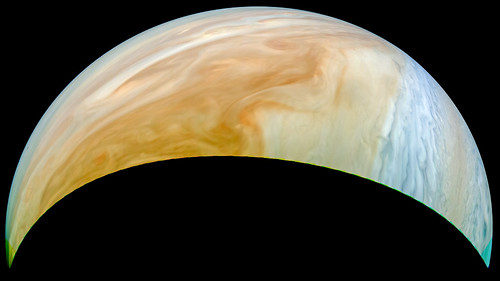
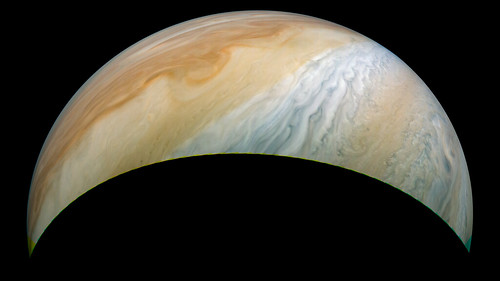
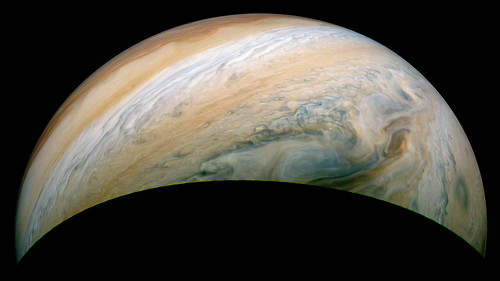

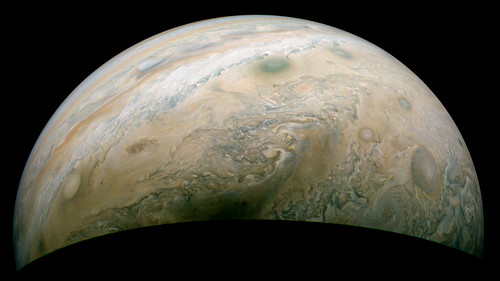
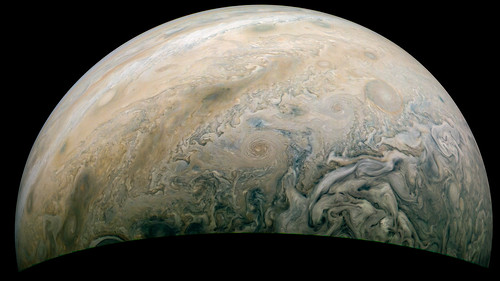
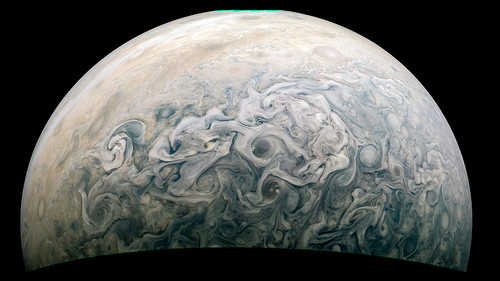

And with a equirectangular panorama:
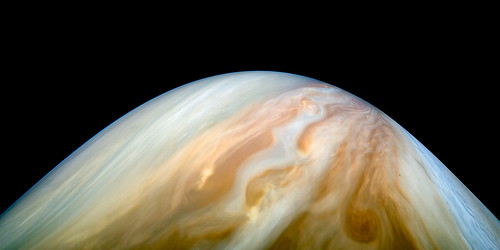









And with a equirectangular panorama:

Here are today's three new images:
Click to view attachment Click to view attachment Click to view attachment
PNG version.
According drafts.
Click to view attachment Click to view attachment Click to view attachment
PNG version.
According drafts.
Wow, those are amazing!
Thanks!
And I'm finally able to create an overview strip using Sean's layout:

Perijove 17 Jupiter Overview as of Jan 3 2019
Image PJ17_21 in approximately true color/contrast versions. In terms of color and field of view these are very roughly comparable to what might be obtained with a regular consumer type camera (or even a phone). However, the resolution is a bit lower.
Click to view attachmentClick to view attachmentClick to view attachment
Enhanced versions:
Click to view attachmentClick to view attachmentClick to view attachment
Metadata:
IMAGE_TIME = 2018-12-21T16:56:30.184
MISSION_PHASE_NAME = PERIJOVE 17
PRODUCT_ID = JNCE_2018355_17C00021_V01
SPACECRAFT_ALTITUDE = 6209.8 km
SPACECRAFT_NAME = JUNO
SUB_SPACECRAFT_LATITUDE = 30.8783
SUB_SPACECRAFT_LONGITUDE = 152.7168
TITLE = PJ17 North Temperate Belt
Resolution at nadir: ~4.2 km/pixel
Click to view attachmentClick to view attachmentClick to view attachment
Enhanced versions:
Click to view attachmentClick to view attachmentClick to view attachment
Metadata:
IMAGE_TIME = 2018-12-21T16:56:30.184
MISSION_PHASE_NAME = PERIJOVE 17
PRODUCT_ID = JNCE_2018355_17C00021_V01
SPACECRAFT_ALTITUDE = 6209.8 km
SPACECRAFT_NAME = JUNO
SUB_SPACECRAFT_LATITUDE = 30.8783
SUB_SPACECRAFT_LONGITUDE = 152.7168
TITLE = PJ17 North Temperate Belt
Resolution at nadir: ~4.2 km/pixel
Here's a processed version of Gerald's draft #22, which includes a candidate moon shadow along the northern edge of the NEB at about the 1 o'clock position.
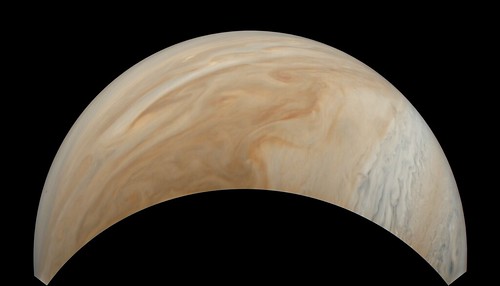 JunoCam - Perijove over the North Equatorial Belt by Justin Cowart, on Flickr
JunoCam - Perijove over the North Equatorial Belt by Justin Cowart, on Flickr
If it is a shadow it shows little visible motion (if any) against the cloud tops in the 4 minutes of observation, but a map-projected version of these images is probably necessary to double check. I haven't been able to find a way to check this hypothesis other than Jupiter Viewer - Thebe is about in the right place but there's not enough information to determine if its sub-Sun point falls on Jupiter. It could just be a lookalike cyclone core (see Machi's post in the Voyager thread)
There is a real moon shadow on the southern horizon though, which is undoubtedly Amalthea. Here's a cropped image to give it the limelight:
Click to view attachment
 JunoCam - Perijove over the North Equatorial Belt by Justin Cowart, on Flickr
JunoCam - Perijove over the North Equatorial Belt by Justin Cowart, on FlickrIf it is a shadow it shows little visible motion (if any) against the cloud tops in the 4 minutes of observation, but a map-projected version of these images is probably necessary to double check. I haven't been able to find a way to check this hypothesis other than Jupiter Viewer - Thebe is about in the right place but there's not enough information to determine if its sub-Sun point falls on Jupiter. It could just be a lookalike cyclone core (see Machi's post in the Voyager thread)
There is a real moon shadow on the southern horizon though, which is undoubtedly Amalthea. Here's a cropped image to give it the limelight:
Click to view attachment
PJ17, part 4, drafts.
It will probably take a few more hours, until I'll have completed the according reprojections, well, unless I'll fall asleep during work after midnight.
It will probably take a few more hours, until I'll have completed the according reprojections, well, unless I'll fall asleep during work after midnight.
Reprojections of the RGBs are online.
The timelapse sequence shows some processing artifacts near the GRS, side effects of the patching algorithm for camera artifacts and energetic particle impacts.
Here the first 10 images of part 4, starting with
#28, #29,
#30, #31:
Click to view attachment Click to view attachment
Click to view attachment Click to view attachment
The timelapse sequence shows some processing artifacts near the GRS, side effects of the patching algorithm for camera artifacts and energetic particle impacts.
Here the first 10 images of part 4, starting with
#28, #29,
#30, #31:
Click to view attachment Click to view attachment
Click to view attachment Click to view attachment
This is a "lo-fi" version of our main content. To view the full version with more information, formatting and images, please click here.































